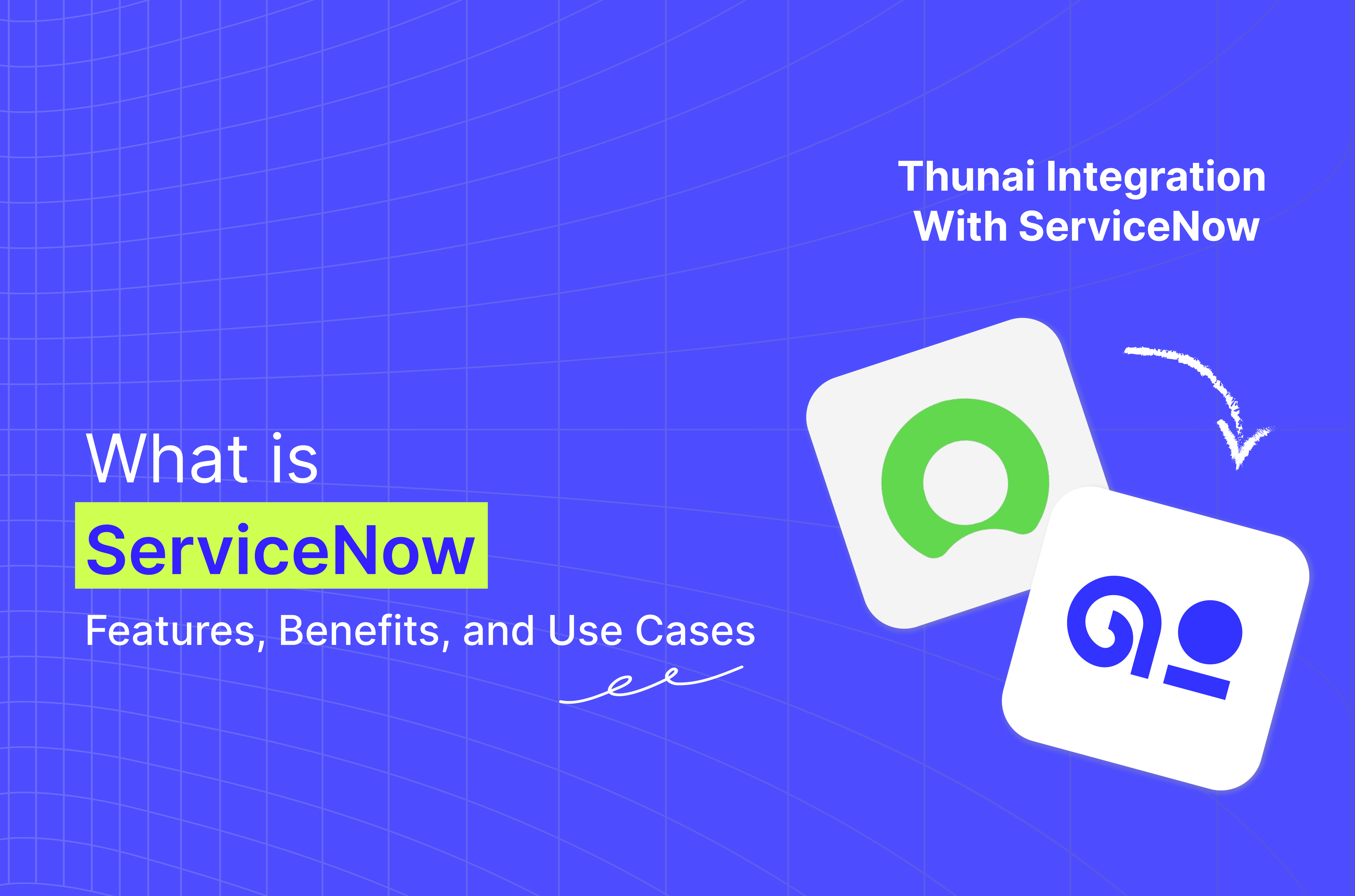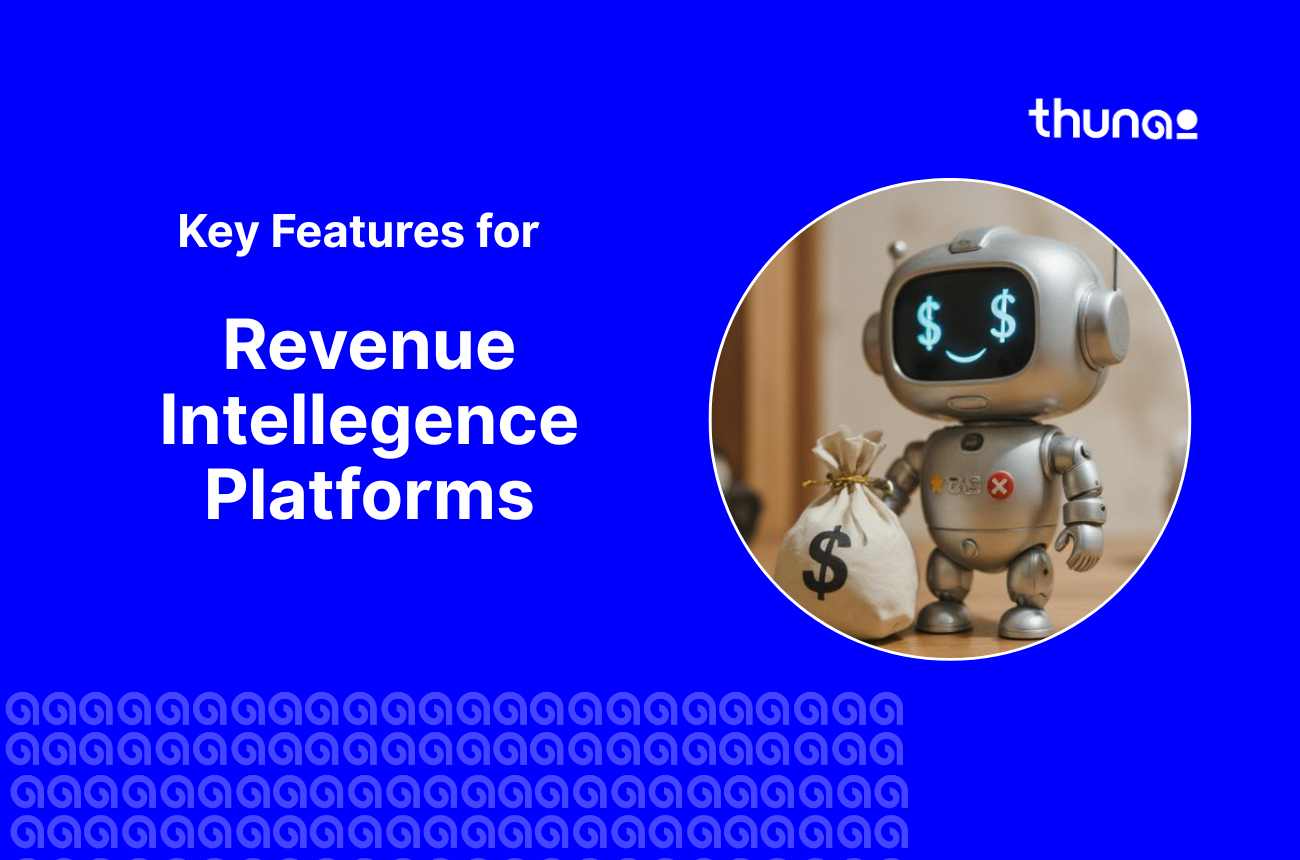What is ServiceNow? Features, Benefits, and Using Thunai ServiceNow Integration



Thunai learns, listens, communicates, and automates workflows for your revenue generation team - Sales, Marketing and Customer Success.
- ServiceNow IT Service Management (ITSM) is a cloud-based platform that streamlines IT service delivery for organizations.
- The platform uses a unified data model on ServiceNow's Now Platform to support robust ITIL processes and efficient ticketing.
- AI tools in ServiceNow ITSM automate work—such as summarizing complex issues to help agents resolve tickets faster.
- Integrating Thunai with ServiceNow boosts scalability, enabling advanced AI voice, chat, and email agents along with other enhanced automation features.
Is your IT help desk finding it hard to keep up with tickets? Are employees getting frustrated with slow responses and having their issues passed from team to team?
Well, ServiceNow ITSM shows a powerful and organized path for managing IT service delivery. It is a path that many of the world's leading companies have gone down to improve their IT support.
This guide will walk you through the main features and primary benefits of ServiceNow's ITSM solution.
What is ServiceNow ITSM?
ServiceNow IT Service Management, or ITSM, is a thorough, cloud-native tool. It lets IT teams manage and automate the delivery of IT services across a whole company. The platform has its roots in ITSM.
The main point of ServiceNow ITSM is to move IT away from manual, disorganized work. Instead, it pushes IT towards automated, efficient processes. This change helps IT teams get better at what they do.
It also improves the experience for all employees who depend on IT services every day. The decision to use ServiceNow ITSM is often the first step a company takes in a larger digital journey.
Key Features of ServiceNow ITSM and ServiceNow Integrations
ServiceNow ITSM's capabilities are broken down into modules. These modules generally match the main processes of the ITIL framework. They all run on the unified Now Platform. This allows them to work together smoothly to give a complete picture of IT operations.
Core ITIL Processes
The platform is known for its strong support for the foundational processes that every IT department needs, especially through the wide range of ServiceNow Integrations.
- Incident Management: This is used to get services back to normal as quickly as possible when something goes wrong. The platform gives a single place to track all incoming IT issues, or incidents. This makes it easier to see what is happening. It also helps speed up resolution times and cuts down on manual work for IT agents.
- Problem Management: This feature helps IT teams find the root cause of recurring incidents. Instead of just fixing the same issue over and over, problem management lets teams look into why the issue keeps happening. Then, they can put a permanent fix in place.
- Change Management: When an IT system needs to be updated or changed, this module helps manage the process. It supplies structured workflows for planning, approving, and carrying out changes. This helps to prevent unexpected outages that a poorly planned change could cause.
- Service Request Management: This handles all the standard requests that employees make to IT. For example, this could be a request for a new laptop, for access to a piece of software, or to reset a password. These requests are often handled through a self-service portal.
- Knowledge Management: This feature allows the IT team to build up a knowledge base. This is a library of helpful articles and how-to guides. This information can help employees solve simple issues on their own. It also helps new IT agents get up to speed on how to fix common problems.
.png)
How ITSM and ServiceNow Integrations Work on the Now Platform
To really get a handle on ServiceNow ITSM's power, you must look at its underlying architecture. The ITSM tool is not a standalone application. Instead, it is a key part of the Now Platform. This platform acts as the foundation for everything ServiceNow does. This setup is what lets the ITSM tool be so flexible and connect to other parts of a business.
I. The Single Data Model
- A key point that sets ServiceNow apart is its Single Data Model. This means all ServiceNow tools, including ITSM, use the same database and structure. So, when an IT agent is working on an incident ticket, they can easily see information about the user who reported it.
- They can also see the specific piece of hardware that is broken. This information is stored in a Configuration Management Database, or CMDB. This gives a single source of truth for all IT assets and services.
- This setup gets rid of the data silos that often happen when IT teams use many different, disconnected tools. With everything in one place, it is much easier to see how different parts of the IT world are connected.
II. The Role of Workflow Automation
The main purpose of the Now Platform is to automate workflows. For ITSM, this means taking the manual steps involved in an IT process and turning them into a hands-off, digital workflow.
- For instance, when a new service request comes in, a workflow can automatically get the needed approvals. It can then create tasks for different teams to carry out.
- This automation is what lowers operational costs and lets IT agents work on more important tasks. Moreover can be improved through the usage of ServiceNow Integrations.
Thunai’s ServiceNow Integration and Its Role in Modernizing IT Service Management
While ServiceNow has its own powerful AI strategy, integrating it with Thunai's "Agentic AI Platform" unlocks a new level of performance. The synergy connects Thunai's specialized AI agents and its central Thunai Brain directly into the ServiceNow ITSM tool, creating a unified ecosystem that drives radical automation.
The goal of this integration is to intercept and automate common, repetitive tasks with Thunai's conversational AI before they even become a burden on human agents.
Thunai's AI learns from a company's entire data landscape—documents, chats, and databases—not just past IT tickets. This allows it to resolve many issues autonomously or, when necessary, create perfectly contextualized tickets in ServiceNow, freeing up IT teams to focus exclusively on complex, high-value problems.
How the Integration Supercharges the IT Service Desk:
- Thunai-Powered Now Assist for ITSM: This integration enhances ServiceNow's generative AI by feeding it superior data from the start.
- A user can call in and interact with a Thunai AI Voice Agent in one of over 150 languages. The agent understands the issue, asks clarifying questions, and then creates a perfectly summarized, pre-triaged ticket in ServiceNow.
- When a human agent opens the ticket, ServiceNow's Now Assist provides a summary of the ticket history, while Thunai's Real-time Agent Assist simultaneously provides live guidance drawn from the entire company knowledge base, not just IT data.
- Hyper-Accurate Predictive Intelligence makes ServiceNow's ticket routing dramatically more accurate. Instead of relying solely on user-submitted text, Thunai's AI agents conduct an intelligent pre-triage. By gathering precise details through a guided conversation, the data used to create the ServiceNow ticket is far richer and more structured.
- Automated, Cross-Platform Knowledge Creation creates a closed-loop system for knowledge management. When an incident is resolved in ServiceNow, the integration can trigger the Thunai Brain to automatically draft a new knowledge article.
- The Thunai ServiceNow Integration with information documented in the ticket and enriches it with relevant context from its own knowledge hub (e.g., technical manuals, past chat logs). The draft is then ready for a quick review and approval, ensuring that valuable solutions are captured and shared effortlessly, continuously making the entire support system smarter.
Primary Benefits of Using ServiceNow ITSM and ServiceNow Integrations
User feedback and market analysis point to several key business advantages that come from using ServiceNow ITSM.
1. Better IT Efficiency and Agent Productivity
A main benefit is the improvement in how efficiently the IT team works. By automating workflows and using AI to help with tasks, agents can get more done.
They spend less time on manual, repetitive work. The platform claims, for instance, that its AI features can improve incident resolution productivity by up to 30%.
2. A Better Experience for Employees
When the IT department runs smoothly, every employee benefits. ServiceNow ITSM gives employees an easy-to-use self-service portal.
Here, they can report issues and request new services 24/7. Because the system is more efficient, they get faster responses and resolutions. This cuts down on frustration and lets them get back to their own jobs sooner.
3. Greater Visibility into IT Operations
Because everything is tracked in one system, IT leaders get a much clearer picture of what is happening. They can use dashboards and reports to see trends.
For example, they can see what kinds of issues are most common or how long it takes to resolve certain tickets. This data helps them make better decisions about where to put money and people.
4. A More Proactive IT Department
The platform helps IT move from being purely reactive to being more proactive. By connecting with IT operations tools, it can automatically create an incident when a system monitoring tool detects a problem.
This means IT can start working on a fix before users even notice something is wrong. This helps prevent major outages and builds trust in the IT department.
Common Use Cases for ServiceNow ITSM and ServiceNow Integrations
The ITSM platform is very flexible. It can be set up to handle a wide range of common IT scenarios in large companies.
- Running a Modern IT Help Desk: This is the most classic use case. A large company uses the incident and request management modules to handle all the daily IT needs of its thousands of employees. Tickets are automatically routed to the right teams.
- Automating New Employee IT Setup: When a new person is hired, they need a lot of things from IT. A service request can be set up in the portal to kick off the whole process. An automated workflow that can use ServiceNow Integrations, then creates tasks for different teams.
- Managing a Major Software Upgrade: Let's say a company needs to roll out a new version of its main business software. The Change Management module is used to plan this big event. The IT team creates a change request that details the plan, the risks, and a back-out plan.
Improving ServiceNow Using the Thunai ServiceNow Integration
In this article, we have looked at the question of what ServiceNow ITSM is. We also went over why it has become a leading platform for managing IT services.
While ServiceNow offers a unified data platform, Thunai’s ServiceNow Integration enhances it by fully automating workflows across disconnected tools. This integration provides a powerful, definitive solution to the core challenges of limited visibility and operational silos.
Thunai’s Agentic AI supercharges ServiceNow, moving it beyond simple ticketing into truly predictive and automated support. This synergy creates a strategic asset that scales with a company’s needs.
By using Thunai’s no-code, rapid deployment capabilities, companies can bypass the need for massive investment in specialized skills and complex planning.
Want to see Thunai in action? Book a free demo!
FAQs on ServiceNow ITSM
What is ITIL and how does ServiceNow ITSM use it?
ITIL stands for Information Technology Infrastructure Library. It is a set of best practices for how to run an IT department. ServiceNow ITSM is built based on these ITIL practices. For example, its modules for Incident, Problem, and Change Management are all named after and follow the ITIL guidelines for those processes.
How does AI help a service desk agent in ServiceNow?
AI helps an agent in a few ways. First, it can automatically assign new tickets to them or their team. Second, it can read a long, complex ticket and give the agent a short summary. This saves them reading time. Third, it can suggest knowledge articles that might help them solve the user's issue faster.
What is the difference between an incident and a service request?
In ITSM, an incident is when something is broken or not working as it should. The goal of incident management is to fix it and get the service back to normal. A service request, on the other hand, is a request for something new. This could be a new piece of hardware, a request for access to a system, or a simple question.
How much does a ServiceNow ITSM license cost?
ServiceNow does not publish its prices. However, based on market analysis, a standard license for a user who works on tickets, often called a Fulfiller, is estimated to be around $90 to $100 per month. The final price can change based on the size of the company and any discounts from the sale.




.png)

